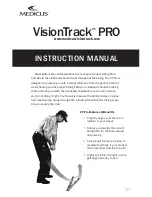
FADE
DR
AW
FA
DE
DR
A
W
diagram 5-2
Ball position without a tee
Tee position
FADE
DR
A
W
FADE
DR
A
W
M
ED
IC
U
S
G
O
LF
80
0.
73
2.
49
95
T
A
R
G
E
T
LO
W P
O
IN
T
RH - POINT
LEFT OF TARGET
LH - P
OIN
T
RIG
HT O
F TA
RGE
T
STANCE WIDTH
RH
LH
diagram 6-1
pg
6
• Start with short swings - try to trace the Swing
Path with the clubhead. Waist high on the
backstroke to waist high on the follow-through
is a good stroke length to begin. Gradually
increase the length of your swing up to full
stroke. Do this without a ball until you develop
a good understanding for where the path.
• When you are ready to hit some balls - set
the ball in the depression or tee it where
the indent is located. (see diagram 5-2)
PRACTICE:
USING THE FAULT SENSOR
• The Fault Sensor helps by indicating when
you have missed your mark. When you hit
the sensor your swing is curving inside the
Swing Path too quickly - follow the direction
of the Swing Path until the clubhead has
passed the Fault Sensor (see diagram 6-1).
PRACTICE:
ADVANCED SHOT SHAPING
HITTING A DRAW
• A Draw is a shot that starts right of
target, in the direction of the swing path,
then curves back towards target.
• Right Hand Players: Aim the VisionTrack PRO™
slightly right of target to compensate for the
ball fl ight curve (the exact amount will vary
based on the amount of Draw required to reach
your intended target). Left Hand Players: Aim
the VisionTrack PRO™ slightly left of target.
• Align your feet squarely to the VT PRO™
Stance Line. Align the leading edge of the
clubface with the line marked “DRAW.”
• Practice maintaining this clubface angle
while accurately tracing the Swing Path. This
precise clubface angle in combination with
the Swing Path you learn with the VT PRO™ is
how you achieve this shot shaping technique.








